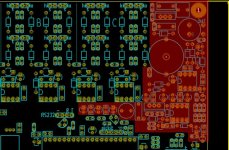Lebowski
10 MW
Yes, the chip doesn't care whether 5V represents 100A or 300A, the chip just regulates until it sees a certain voltage swing coming from the current sensors...
IGBT's, for the voltages I run (80 to 120V) they don't make much sense so I've never used them. I would assume a IPM module has drivers etc inside, and will
just take the logic signals straight from the controller IC ? That's what I remember from the datasheets bluefang showed me.
I would use 2 version 1's and 2 version 2's. When running the HF tone, the chip is amazingly sensitive to the inductances it sees. Two HF tones on one motor
might bite each other. You can set the chips up to generate tones of different frequencies, I think this would give you a fighting chance. But what I would try is
a combination of a v2 and a v1 setup for push-start. In such a combination the v2 will give you torque from standstill. With this torque, at the slightest rotation
the v1 will start and then both controllers will be powering the motor. It would be interesting to see what happens. And, if it turns out two v2's works OK, I can
always reflash the v1's to v2's. The schematic change is really small as you can see from the KiCad database. (you can even run a v2 on a v1 board when you
connected the hall sensor from pin 6 to ground, this makes the FOC a little less accurate though)
IGBT's, for the voltages I run (80 to 120V) they don't make much sense so I've never used them. I would assume a IPM module has drivers etc inside, and will
just take the logic signals straight from the controller IC ? That's what I remember from the datasheets bluefang showed me.
I would use 2 version 1's and 2 version 2's. When running the HF tone, the chip is amazingly sensitive to the inductances it sees. Two HF tones on one motor
might bite each other. You can set the chips up to generate tones of different frequencies, I think this would give you a fighting chance. But what I would try is
a combination of a v2 and a v1 setup for push-start. In such a combination the v2 will give you torque from standstill. With this torque, at the slightest rotation
the v1 will start and then both controllers will be powering the motor. It would be interesting to see what happens. And, if it turns out two v2's works OK, I can
always reflash the v1's to v2's. The schematic change is really small as you can see from the KiCad database. (you can even run a v2 on a v1 board when you
connected the hall sensor from pin 6 to ground, this makes the FOC a little less accurate though)


